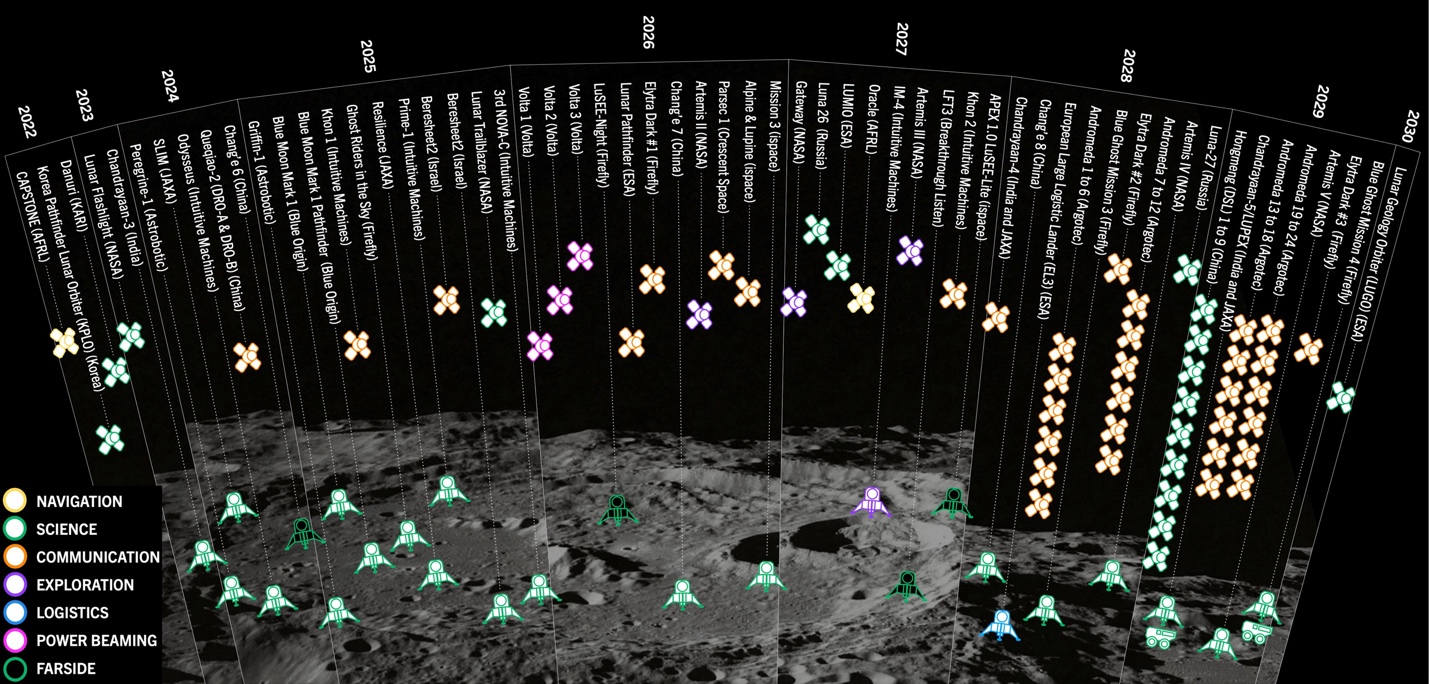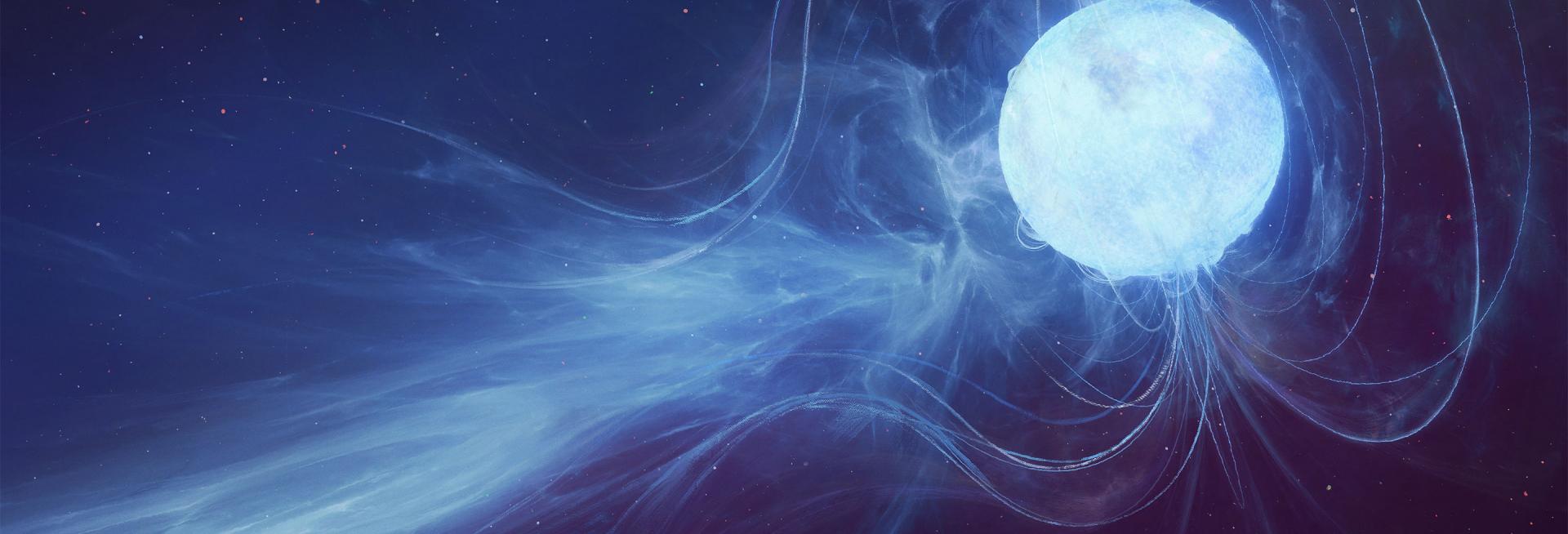Enhancing the Breakthrough Listen Technosignature Search through Signal Classification in Radio Data
Supervisors: Steve Croft and Chris Lintott

This project aims to improve the search for extraterrestrial intelligence by deploying cutting-edge machine learning.
Breakthrough Listen, the world's most comprehensive, sensitive, and intensive search for technosignatures (indicators of technology as a proxy for extraterrestrial intelligence) is gathering enormous amounts of data from telescopes around the world and across the electromagnetic spectrum. The Listen archive includes petabytes of data from radio observatories: both single dish telescopes like the Green Bank Telescope, and antenna arrays such as MeerKAT. The primary challenge for radio technosignature searches is the characterisation of a vast haystack of signals from human-generated radio frequency interference (RFI) in search of elusive needles that might be candidate technosignatures.
Breakthrough Listen, headquartered in the Sub-department of Astrophysics at Oxford, has employed a variety of signal detection and classification techniques, including deep learning approaches such as neural networks and autoencoders. Deep learning is a rapidly evolving field, however, and approaches such as normalising flow models offer promising new ways to understand the morphologies of radio signals. As well as enabling tighter constraints on the prevalence of technosignatures, these approaches will also allow for better characterisation of the RFI environment at radio telescopes - a critical task given the dramatic growth in interference from satellite constellations. There will also be the opportunity to leverage prior work in machine learning to improve the detection of astrophysical transients such as fast radio bursts.
This project does not require prior experience with radio astronomy, but some experience in training deep learning models would be beneficial.
Galactic explosions and their fallout
Supervisor: Katherine Blundell
Nova explosions occur much more frequently than supernova events and arise as the result of a thermonuclear runaway on the surface of a white dwarf in orbit with a more normal star. Our discovery of jets being ejected at the onset of a nova explosion, which have speeds of a few thousand km/s, suggests an important means by which the inter-stellar medium can be enriched by the products of nucleosynthesis that take place on the surface of the white dwarf. The goal of this doctoral programme is to investigate the mechanisms by which these processes take place, to investigate the nature of the accretion discs that launch the outflows, as well as identify the efficacy of enrichment of the ISM by jets from nova explosions, using time-lapse spectroscopy data from the Global Jet Watch (PI K Blundell; www.GlobalJetWatch.net).
Magnetised plasma turbulence: from laser lab to galaxy clusters
Supervisors: Gianluca Gregori, Archie Bott, Alexander Schekochihin
There are a number of possibilities within this project to design, take part in, and theorise about laboratory experiments employing laser-produced plasmas to model astrophysical phenomena and basic, fundamental physical processes in turbulent plasmas. Recent examples of our work in this field include turbulent generation of magnetic fields ("dynamo") [1,2], supersonic turbulence mimicking star-forming molecular clouds [3], diffusion and acceleration of particles by turbulence [4,5], suppression of thermal conduction in galaxy-cluster-like plasmas [6]. Our group has access to several laser facilities (including the National Ignition Facility, the largest laser system in the world). Students will also have access to a laser laboratory on campus, where initial experiments can be fielded. Depending on the student's inclinations, it is also possible to pursue a project focused on theory and/or numerical modelling of plasma phenomena in astrophysical and laboratory-astrophysical environments.
References:
- P. Tzeferacos et al., "Laboratory evidence of dynamo amplification of magnetic fields in a turbulent plasma," Nature Comm. 9, 591 (2018) (2019 APS Dawson Prize)
- A. F. A. Bott et al., "Time-resolved fast turbulent dynamo in a laser plasma," PNAS 118, e2015729118 (2021) (2020 EPS PhD Award in Plasma Physics)
- T. G. White et al.,"Supersonic plasma turbulence in the laboratory," Nature Comm. 10, 1758 (2019)
- A. F. A. Bott et al., "Proton imaging of stochastic magnetic fields," J. Plasma Phys. 83, 905830614 (2017)
- L. E. Chen et al., "Transport of high-energy charged particles through spatially intermittent turbulent magnetic fields," Astrophys. J. 892, 114 (2020)
- J. Meinecke et al., "Strong suppression of heat conduction in a laboratory analogue of galaxy-cluster turbulent plasma," Science Adv. 8, eabj6799 (2022)
Microphysics of Gamma-ray Bursts
Supervisors: Gianluca Gregori, Subir Sarkar, Dmitri Uzdensky
Gamma-ray bursts (GRBs) are among the most energetic events in the Universe. They occur at cosmological distances and are the result of the collapse of massive stars or neutron stars mergers, with emission of relativistic "fireballs" of electron-positron pairs. From astrophysical observations, a wealth of information has been gleaned about the mechanism that leads to such strong emission of radiation, with leading models predicting that this is due to the disruption of the beam as it blasts through the surrounding plasma. This produces shocks and hydromagnetic turbulence that generate synchrotron emission, potentially accelerating to ultra-high energies the protons which are observed on Earth as cosmic rays. However, there is no direct evidence of the generation of either magnetic fields or cosmic rays by GRBs. Estimates are often based on crude energy equipartition arguments or idealized numerical simulations that struggle to capture the extreme plasma conditions. We propose to address this lacuna by conducting laboratory experiments at accelerator facilities to mimic the jet propagation through its surrounding plasma. Our intial work [1] has demonstrated that we can create enormous beams of electron-positron plasmas that have properties very similar to GRB Fireballs. We are now planning new experiments at CERN as well as at Laboratori Nazionali Frascati (INFN, Italy) to fully characterize the interaction of these beams with a surrounding (ambient) plasma. Such experiments will enable in-situ measurement of the plasma properties, with exquisite details that cannot be achieved elsewhere. The experiments also complement numerical simulations by providing long measurement times extending into the non-linear regime where numerical simulations are not possible today. The proposed experiments will study fundamental physics processes, unveil the microphysics of GRBs, and provide a new window in high energy astrophysics using novel Earth-based laboratory tools.
Background Reading:
- C. D. Arrowsmith et al., "Laboratory realisation of relativistic pair-plasma beams," Nature Comm. 15, 5029 (2024)
Two projects on black hole accretion and jet formation as part of a large European team
Black holes are the sites of the most extreme physics in the universe since the Big Bang. Their most poorly understood characteristic is the formation of powerful collimated outflows of mass and energy, moving at extremely high speeds away from the region of the event horizon. These ‘relativistic jets’ can have a huge impact on their surrounding environments, even regulating the growth of the most massive galaxies on cosmic scales.
Black holes also span an enormous range in masses and hence timescales. In the lowest mass black holes, stellar-mass black holes in ‘X-ray binary’ systems, we can track the jets from their formation and launch at just a handful of event horizon radii to their eventual deceleration and termination in the interstellar medium a year or so later. Our team in Oxford leads the world in studying the connection between these jets and the inner accretion flow, as well as their late-time deceleration phases, where they finally dissipate their launch energy in the ambient interstellar medium. We lead major guaranteed-time radio observing programmes of black holes on a number of radio telescope arrays, including MeerKAT in South Africa, as well as working at the interface between observation, interpretation and numerical modelling.
We have two four-year DPhil positions available to work on aspects of black hole accretion and jet formation. These projects are funded as part of a large European project, Blackholistic, a partnership between The University of Oxford, The University of Amsterdam and Radboud University. The project is affiliated to the large Event Horizon Telescope collaboration. As a result we encourage applications from candidates who are keen to work in a large and dynamic international team, and who are enthusiastic to work both with data and their interpretation.

Project 1: Relativistic jets from black holes on the smallest to the largest scales
Supervisors: Prof Rob Fender, Dr Andrew Hughes and Dr James Matthews
In this project we will utilise observations with the MeerKAT and expanded MeerKAT+ radio telescope arrays to study large-scale relativistic jets from stellar-mass black holes (and maybe neutron stars) within our galaxy. We will measure the speeds of the jets to compare to physical quantities such as black hole spin, and track and model how they decelerate as they transfer their launch kinetic energy to heating the local interstellar medium. We will also work with numerical relativistic simulations to maximally extract physics from the data. The successful applicant to this project will also join the imaging team for the Event Horizon Telescope project as they expand their sample to study the event horizon and jet base physics for a large number of nearby supermassive black holes. The results from this project will feed into the wider Blackholistic programme which aims to unify black hole accretion and jet production across 8 orders of magnitude in black hole mass.
Project 2: Probing the inner regions of black hole accretion and ejection
Supervisors: Prof Rob Fender, Dr Joe Bright and Dr James Matthews
In this project we will use observations at millimetre wavelengths to study explosive black hole accretion and jet launch events and other extreme astrophysical transients such as gamma ray bursts and tidal disruption events. Millimetre observations probe much closer to the black hole event horizon or jet launch point than traditional radio observations, as the synchrotron-emitting ejecta become optically thin much earlier at higher frequencies. This in turn has the potential to tell us about the internal physics (such as reverse shocks), expansion rate and energetics of jet ejections at times before we are able to spatially resolve them with interferometers. Furthermore, in recent years new populations of unknown millimetre transients have been discovered. These observations and analyses, using existing facilities such as the JCMT, will lay the foundations for the millimetre transients programme on the Africa Millimetre Telescope, which should see first light in 2028 or 2029. The successful applicant will therefore have the chance to be involved in the very first observations with this exciting new facility. The successful applicant will also work on relativistic numerical modelling, both at Oxford and with our partner institutions in The Netherlands, providing critical comparisons between models of the inner, relativistic, accretion flow, and data. Finally they will have the opportunity to join the modelling (or other) working groups of the Event Horizon Telescope project. The results from this project will feed into the wider Blackholistic programme which aims to unify black hole accretion and jet production across 8 orders of magnitude in black hole mass.
Understanding the population of radio pulsars using MeerKAT
Supervisors: Aris Karastergiou
Using pulsars for experiments in fundamental physics relies more and more on a detailed understanding of the physics of neutron stars. Despite many decades of progress in the field, there remain open fundamental questions, such as the birth periods of pulsars, the mechanism by which they evolve with time, and the radio emission mechanism.
The Thousand Pulsar Array survey with the MeerKAT telescope in South Africa is providing a paradigm setting dataset of a very large population of radio pulsars, observed monthly. Time-domain and imaging data are both recorded and analysed. In addition to revealing how a large population of pulsars evolve with time, monthly monitoring allows us to separate those effects that are intrinsic to the star from those related to propagation of the radiation as it travels through the intervening media. The student will work within an international collaboration (www.meertime.org) to address key questions in pulsar population studies, relating to understanding the cold and dense nuclear matter in neutron star interiors, the plasma physics processes the occur in pulsar magnetospheres, the properties of the ionized and magnetized interstellar medium, and the birth and evolution of neutron stars. Understanding the neutron star population has far reaching impact in astrophysics and Gravitational Wave astronomy.
Machine learning for the Vera C. Rubin Observatory
Supervisors: Chris Lintott, Steve Croft
 In the era of large surveys such as the Vera Rubin Observatory, the task of finding unusual interesting objects is necessarily handled by machine learning. This project, which will cover the period which includes the first major data releases from the observatory’s Legacy Survey of Space and Time, will develop and deploy the necessary tools to find the most unusual objects in the 30TB of imaging produced each night. It builds on our existing work with advanced methods using variational autoencoders (VAEs) to encapsulate what is already known about objects in astronomical catalogues, and to use flow models to reveal otherwise hidden features and correlations. Across the observatory’s diverse science cases there are many opportunities to look for unusual, interesting things - a task which requires careful utilisation of machine learning tools. This project will apply such tools to finding unusual transients in the alert stream, looking for unidentified types of transient, and searching for anomalous behaviour more generally, including constraining a variety of models for technosignatures as part of the Breakthrough Listen Initiative.
In the era of large surveys such as the Vera Rubin Observatory, the task of finding unusual interesting objects is necessarily handled by machine learning. This project, which will cover the period which includes the first major data releases from the observatory’s Legacy Survey of Space and Time, will develop and deploy the necessary tools to find the most unusual objects in the 30TB of imaging produced each night. It builds on our existing work with advanced methods using variational autoencoders (VAEs) to encapsulate what is already known about objects in astronomical catalogues, and to use flow models to reveal otherwise hidden features and correlations. Across the observatory’s diverse science cases there are many opportunities to look for unusual, interesting things - a task which requires careful utilisation of machine learning tools. This project will apply such tools to finding unusual transients in the alert stream, looking for unidentified types of transient, and searching for anomalous behaviour more generally, including constraining a variety of models for technosignatures as part of the Breakthrough Listen Initiative.
The project will also search for unusual galaxies, looking particularly at low surface brightness features. There may also be a chance to work with Rubin Solar System data (see https://arxiv.org/abs/2401.08763). It will thus provide a broad grounding across observational astrophysics, at a time when large volumes of data are first being produced.
There will also be an opportunity, if the student is interested, to work on follow-up of systems or events identified through ML, or to make use of distributed citizen science through the Zooniverse platform. The project does not require prior knowledge of machine learning, but would suit a student who is comfortable with coding and willing to learn.
Science From the Moon
Supervisors: David DeBoer, Kris Zarbadami, Neil Bowles
We uniquely rely on radio telescopes to understand the bulk of baryonic matter in the early Universe and the evolution of the Universe across early Cosmic times. There are two unavoidable limitations to our exploration of the Cosmos with terrestrial-based radio telescopes:
- the prevalence of interfering radio transmissions from human activity, and
- the Earth’s ionosphere and atmosphere, which are opaque or disruptive to many important radio frequency ranges.
These limitations are overcome by reaching above the atmosphere and beyond Earth, a capability that, to date, has generally been the exclusive purview of expensive, government-funded space-based “Great Observatories”.
However, we are now on the cusp of a new era, with cost-effective and opportunity-laden access to space (including the lunar surface) becoming a reality. Such unfettered access will enable disparate groups to send instruments there, bringing about a transition from Earth-based observatories to space-based and cislunar telescopes (Fig. 1). Although this shift provides exciting opportunities for new science, it will also introduce sources of radio frequency interference (RFI) to the quietest remaining location to which we have access: the lunar Farside. Measurements from a generally RFI-free environment must be taken before the lunar skies have a multitude of orbiters.

One mission in the planning stage is the Lunar Farside Technosignature and Transients Telescope (LFT3). Being led out of Oxford, this mission would seek to arrive on the lunar farside surface before 2030, to take unique-in-history measurements from 1 - 2700 MHz.. The science case is wide and spans technosignatures, transients, cosmology and lunar studies. This project would explore instrumentation for scientific outcomes for LFT3 and any potential “ride-along” instruments. This could include all mission aspects as well as foundational and preparatory science and instrumentation. The overall goal is science from the Moon, which also includes regolith studies and operations from the Moon. Specifically, this project would work with the LFT3 instrument design and strive to maximize the scientific impact of the data to be collected from the Moon at this unique time.

